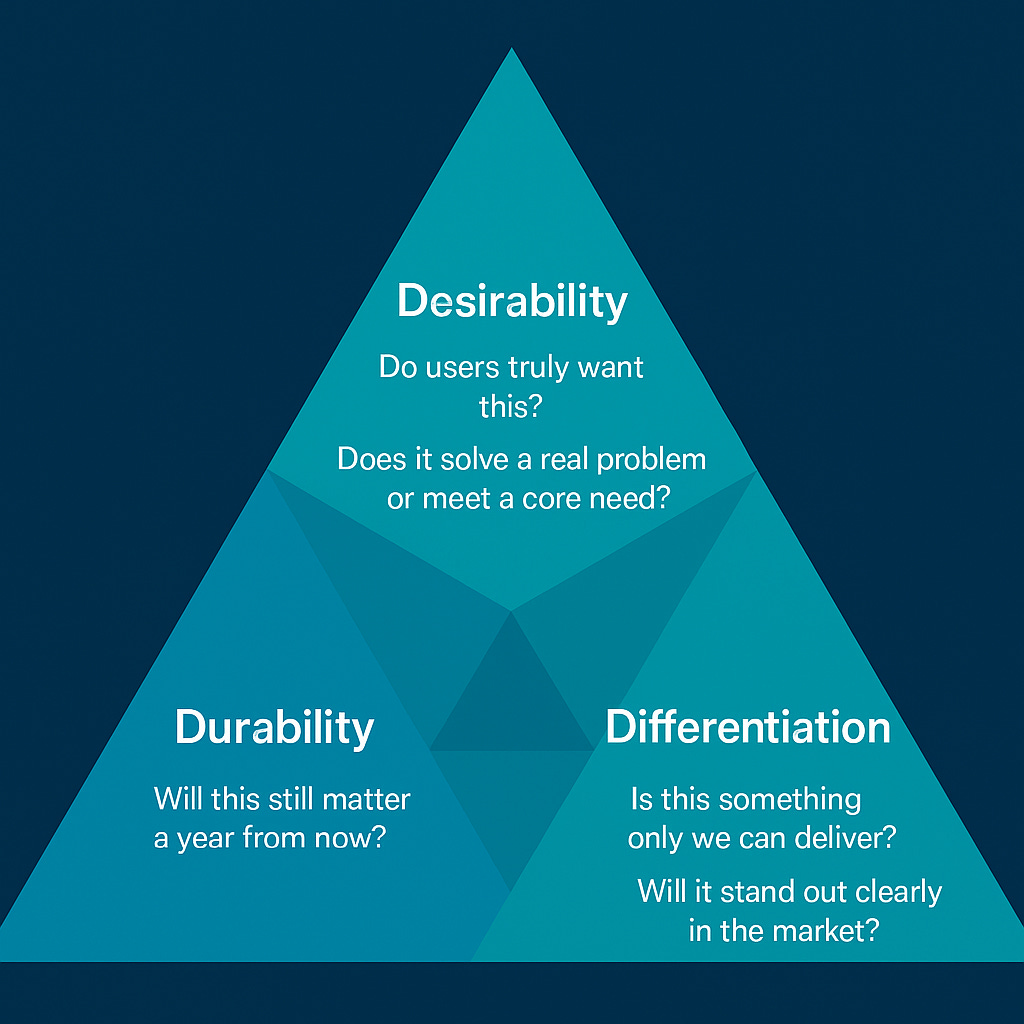Product Strategy Isn’t a Deck. It’s a Set of Decisions.
Why great product strategy isn’t what’s in the deck. It’s what you’re willing to walk away from.
🎧 Now a Podcast Conversation
This article sparked a new episode of The Product Leader’s Playbook, where our AI hosts unpack how real strategy shows up in trade-offs, not templates, and why most roadmaps collapse without decisions behind them.
→ 🎙 Listen on Spotify | Listen on Apple Podcasts
“It is much easier to write ten volumes of philosophy than to put one principle into practice.”
— Blaise Pascal
We’ve all seen it.
A polished strategy deck with dozens of slides. Bold vision. Impressive charts. A twelve-month roadmap that seems airtight.
But then the work begins. Sprint planning. Resourcing. Prioritization.
And the cracks start to show, because there’s no strategy behind the slides, only storytelling.
🔍 Strategy Lives in the Trade-Offs
Strategy isn’t a document. It’s a series of visible, irreversible decisions.
Most teams confuse clarity of presentation with clarity of direction. But until the hard choices are made, and made visible, your roadmap is just a guess.
Real strategy answers uncomfortable questions:
Given our goals and constraints, what will we prioritize? What will we ignore?
Where will we go deeper than our competitors?
What near-term wins are we willing to skip to pursue long-term momentum?
You don’t align teams with lofty statements. You align them by showing them what matters most, what doesn’t, and why.
📊 The Myth of the Deck
Strategy decks create the illusion of alignment. They look sharp, sound thoughtful, and feel complete, but they stop short of action.
They summarize aspirations, not trade-offs. They describe the market but don’t clarify how you plan to win. They catalog customer needs without declaring which to prioritize, and which to leave behind.
A strategy that doesn’t say no to anything isn’t strategy. It’s storytelling.
The danger isn’t that the deck is wrong. It’s that it feels right, even when no real decisions have been made.
Planning is easy when everything fits. Strategy begins when it doesn’t.
🧠 The 3D Strategy Filter
When priorities feel scattered, it’s usually because the team hasn’t agreed on how to evaluate them.
That’s where the 3D Strategy Filter comes in. It helps teams distinguish strategic bets from noise using three clear lenses:
1. Desirability
Do users truly want this? Does it solve a real need or pain point?
Desirability is about more than feature requests. It’s about validated demand.
2. Differentiation
Is this something only we can deliver? Will it stand out in the market?
If a competitor can match it in a sprint, it probably won’t create leverage.
3. Durability
Will this still matter a year from now?
Some work creates momentum that compounds. Other work fades quickly. Know which is which.
Desirability gets attention. Differentiation earns trust. Durability builds momentum.
Take an AI-powered feature, for example. Users are excited. That checks the box for Desirability. But competitors are all building something similar, and the tech is evolving fast. That may hurt Differentiation and Durability.
Does it still make sense? Maybe. But now you’re making that decision with eyes wide open.
Strategic clarity isn’t about certainty. It’s about consistently applying the same lens to every bet.
🗺 Roadmap as Output, Not Strategy
The roadmap is not the strategy. It’s the result of it.
When teams confuse the two, they start managing to the plan instead of leading with purpose. They ship features because they’re on the list, not because they’re the right next step. And when priorities shift, which they always do, the roadmap crumbles.
A strong roadmap reflects the decisions you’ve already made. It shows what matters most, what’s on hold, and what has been deliberately excluded.
If your roadmap feels bloated, chaotic, or political, there’s usually one reason: the strategic decisions behind it haven’t been made, or they haven’t been shared.
This is where the 3D filter adds value. It provides a shared lens for deciding what gets added and what gets cut. Without it, everything is up for debate and nothing is defensible.
🎯 From Tactics to Strategic Leadership
Many product managers are stuck in the middle.
They own the roadmap but not the strategy. They ship features but don’t shape direction. They attend the meetings but don’t drive the decisions.
This isn’t a skills gap. It’s a mindset shift.
Tactical product managers ask:
What should we build?
Strategic product leaders ask:
What are we really trying to achieve, and what trade-offs are we willing to make?
The shift happens when you stop treating the roadmap as a checklist and start treating it as a reflection of your bets. When you stop chasing consensus and start creating clarity. When you build not just for users, but with purpose.
Product strategy isn’t a deliverable. It’s a pattern of decisions that compound over time.
The best product leaders make those decisions visible, defensible, and durable - especially when it would be easier not to.
💬 Let’s Discuss
Some questions to take back to your team:
Which roadmap items are backed by strategic decisions we can clearly explain?
Where are we prioritizing without a shared filter?
What features are desirable but lack true differentiation or long-term value?
Are we managing the roadmap, or are we letting it manage us?
🎧 Want to Go Deeper?
This article is discussed in a podcast episode of The Product Leader’s Playbook, streaming everywhere:
🔹 Spotify | 🔹 Apple Podcasts | 🔹 YouTube | 🔹 Amazon Music



